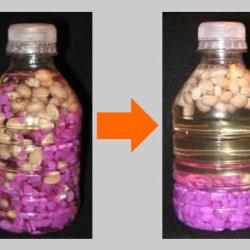Source Institutions
Source Institutions
Add to list Go to activity
Activity link broken? See if it's at the internet archive

In this activity, learners investigate the Moon's infancy and model how an ocean of molten rock (magma) helped shape the Moon that we see today. Learners create a simple model of this process by mixing household items of different densities in a bottle and allowing to them to settle into separate layers. Learners decide which materials make the best model for the infant Moon. Learners may examine a type of Earth rock (named anorthosite) that is also found on the Moon and that would have been shaped by the processes explored here.
This activity station is part of a sequence of stations that can be set up to help learners trace the Moon's 4.5-billion-year history from "infancy" to the imagined future. Learners tie together major events in the Moon's geologic history as a series of comic panels in their Marvel Moon comic books.
This activity station is part of a sequence of stations that can be set up to help learners trace the Moon's 4.5-billion-year history from "infancy" to the imagined future. Learners tie together major events in the Moon's geologic history as a series of comic panels in their Marvel Moon comic books.
- 10 to 30 minutes
- 10 to 30 minutes
- Over $20 per group of students
- Ages 8 - 14
- Activity, Lesson/Lesson Plan, Model
- English
Quick Guide
Materials List (per group of students)
- butcher paper, newspapers, or disposable table cloths for the activity area (optional)
- 5 (8 oz.) unopened, clear plastic water bottles with the labels removed
- A selection of at least three of the following items that sink in water, each placed in a container: 1/2 cup (nearly 1/2 pound) small aquarium gravel, 1/2 cup buttons, 1/2 cup dried navy beans, 1/2 cup marbles, 1/2 cup sequins, 1 cup pancake syrup in its bottle with pour spout
- A selection of at least three of the following items that float in water, each placed in a container: 1/2 cup coffee stirrers (i.e. small straws) cut into 1/4" sections, 1 dry sponge cut into (1/4"x1/4") pieces, 1/2 cup pony beads, 1/2 cup small Lego® pieces (1x1 bricks), 1/2 cup wooden beads, 1/2 cup vegetable oil in its bottle with pour spout
- 1 (32–oz.) bottle of light corn syrup (optional but recommended)
- 2 clear cups
- 1 handheld, wire mesh sieve
- 1 cup water
- scissors (optional)
- 1 (1–quart) bag for creating coffee stirrer sections (optional)
- 1 funnel
- Towel for cleaning up spills
- wet wipes (optional)
- pitcher or bucket for collecting unwanted water (optional)
- 1 sample of Earth anorthosite
- Moon Map: Lunar Highlands
- Infant Moon: Moon Mix! station sign
- Infant Moon: Moon Mix! children's guide
- Art materials, such as colored pencils, crayons, and markers
- Infant Moon comic panels
- Marvel Moon comic books
- Binder clips
- Access to water
- 1 permanent marker
- Pens or pencils
Subjects
-
Earth and Space Science
-
Astronomy
- Origins of Universe
-
Earth Processes
- Volcanoes and Plate Tectonics
-
Earth Structure
- Rocks and Minerals
-
Earth's History
- Geologic Time
-
Solar System
- The Moon
- Origin of Solar System
-
Astronomy
-
Physical Sciences
-
Structure and Properties of Matter
- Mass and Weight
- Volume and Density
-
Structure and Properties of Matter
-
The Nature of Science
-
The Scientific Process
- Conducting Investigations
-
The Scientific Process
Informal Categories
- Model Building
Audience
To use this activity, learners need to:
- see
- see color
- read
- touch
Learning styles supported:
- Involves teamwork and communication skills
- Involves hands-on or lab activities
Other
Components that are part of this resource:
Includes alignment to state and/or national standards:
This resource is part of:
- Lunar and Planetary Institute Educator Resources
- Explore! Marvel Moon
- Growing up Moon (activity series)
Access Rights:
- Free access
By:
Rights:
Funding Sources:
- NASA Lunar Science Institute
- Center for Lunar Origins and Evolution
